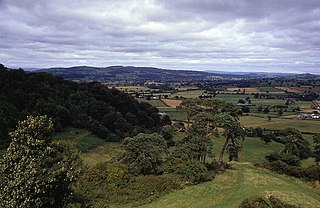
Chirk is a town and community in Wrexham County Borough, Wales, 10 miles south of Wrexham, between it and Oswestry. At the 2011 census, it had a population of 4,468. Historically in the traditional county of Denbighshire, and later Clwyd, it has been part of Wrexham County Borough since a local government reorganisation in 1996. The border with the English county of Shropshire is immediately south of the town, on the other side of the River Ceiriog.

Sir Thomas Myddelton (1586–1666) of Chirk Castle, Denbighshire, was an English-born Welsh landowner, politician, and military officer. He became a Member of Parliament in 1624; during the First English Civil War he was a prominent Parliamentarian general, despite having no previous military experience.
Sir Thomas Myddelton was a Welsh merchant who was Lord Mayor of London before becoming a Member of Parliament for London.

Montgomery Castle is a stone-built castle looking over the town of Montgomery in Powys, Mid Wales. It is one of many Norman castles on the border between Wales and England.

The first High Sheriff of Denbighshire was John Salusbury, snr, appointed in 1540. The shrievalty of Denbighshire, together with that of Flintshire, continued until 1974 when it was abolished after the county and shrievalty of Clwyd was created.

Sir William Vaughan was a cavalry officer in the armies of Charles I of England. Initially serving in Ireland during the Confederate Wars, the outbreak of the First English Civil War led to him being sent to England in 1644, at the head of an Anglo-Irish cavalry regiment, to reinforce the Royalist army.

Booth's Uprising, also known as Booth's Rebellion or the Cheshire Rising of 1659, was an unsuccessful attempt in August 1659 to restore Charles II of England. Centred on North West England and led by George Booth, it took place during the political turmoil that followed the resignation of Richard Cromwell as head of The Protectorate.
![<span class="mw-page-title-main">Thomas Mytton</span> Welsh [[Puritan]], soldier and politician (ca.1597-1656)](https://upload.wikimedia.org/wikipedia/commons/thumb/3/35/Thomas_Mytton_Harding.jpg/320px-Thomas_Mytton_Harding.jpg)
Major General Thomas Mytton, also spelt Mitton, 1597 to November 1656, was a lawyer from Oswestry who served in the Parliamentarian army during the Wars of the Three Kingdoms and as MP for Shropshire in the First Protectorate Parliament.

Sir Richard Myddelton, 3rd Baronet, of Chirk Castle, Denbighshire, was a Welsh landowner and Tory politician who sat in the House of Commons from 1685 to 1716.

Sir Thomas Myddelton, 1st Baronet was a Welsh politician who sat in the House of Commons variously between 1646 and 1663. He supported the Parliamentary cause in the English Civil War but later took part in the Cheshire Uprising (1659) in support of the Restoration.

Sir Thomas Myddelton, 2nd Baronet was a Welsh politician who sat in the House of Commons between 1679 and 1681.

The Battle of Montgomery took place during the First English Civil War of 1642–1646. On 17 September 1644, a Parliamentarian force commanded by Sir John Meldrum advanced to engage a Royalist army led by Lord Byron which was besieging Montgomery Castle in mid Wales. The battle was fought the next day. After the Royalists gained an initial advantage, the Parliamentarians counter-attacked and destroyed Byron's army.

Edward Herbert, 3rd Baron Herbert of Chirbury was an English aristocrat and soldier.
This article is about the particular significance of the year 1726 to Wales and its people.
This article is about the particular significance of the year 1718 to Wales and its people.

The Battle of Winnington Bridge, often described as the last battle of the Civil War, took place on 19 August 1659 during Booth's Uprising, a Royalist rebellion in north-west England and Wales.

The Battle of Denbigh Green took place during the closing stages of the First English Civil War. Fought just outside the Royalist garrison of Denbigh, it has been described as probably the only action in the North Wales theatre of the war "meriting the description of battle".

The Battle of Y Dalar Hir took place on 5 June 1648 in Caernarfonshire, North Wales, during the Second English Civil War. While little more than a skirmish, it had a significant effect on the local progress of the conflict.

Colonel Robert Ellice of Gwasnewydd was a Welsh professional soldier who served in the Royalist army in the English Civil War.

The Myddelton family were substantial landowners and benefactors in and around Denbigh in the north-east of Wales. As landowners and members of parliament, a number of its members were elevated to the baronetcy. For several generations, the family were governors of Denbigh Castle and owned Chirk Castle well into the 20th century.










![<span class="mw-page-title-main">Thomas Mytton</span> Welsh [[Puritan]], soldier and politician (ca.1597-1656)](https://upload.wikimedia.org/wikipedia/commons/thumb/3/35/Thomas_Mytton_Harding.jpg/320px-Thomas_Mytton_Harding.jpg)









